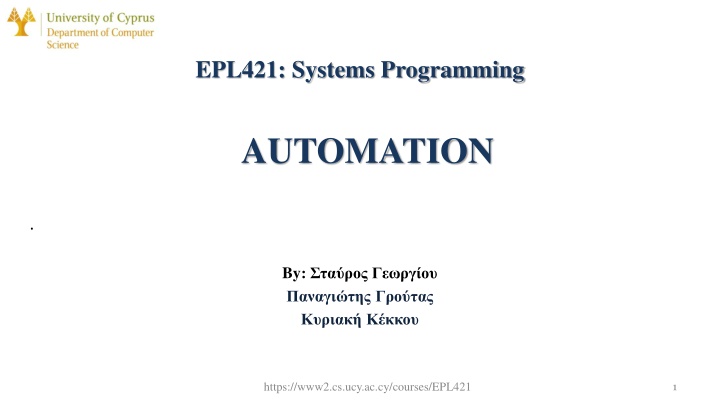
Systems Programming Automation with Jenkins, Gradle, and GitHub
Explore the automation in software build through Continuous Integration tools like Jenkins, Gradle, and GitHub. Learn about build automation, build-automation utilities, and servers, emphasizing Continuous Integration Servers. Continuous Integration practice accelerates software development by frequent code integration verified through automated builds.
Download Presentation

Please find below an Image/Link to download the presentation.
The content on the website is provided AS IS for your information and personal use only. It may not be sold, licensed, or shared on other websites without obtaining consent from the author. If you encounter any issues during the download, it is possible that the publisher has removed the file from their server.
You are allowed to download the files provided on this website for personal or commercial use, subject to the condition that they are used lawfully. All files are the property of their respective owners.
The content on the website is provided AS IS for your information and personal use only. It may not be sold, licensed, or shared on other websites without obtaining consent from the author.
E N D
Presentation Transcript
EPL421: Systems Programming AUTOMATION . By: https://www2.cs.ucy.ac.cy/courses/EPL421 1
Contents Introduction Build Automation Continuous Integration Toolchain Jenkins Gradle Git (GitHub) Toolchain Setup and examples https://www.cs.ucy.ac.cy/courses/EPL646 2
Introduction Automation in software build with Continuous Integration (CI) Toolchain is the key for build Automation In our project, we used Jenkins, Gradle and GitHub https://www.cs.ucy.ac.cy/courses/EPL421 3
Software Build The process in which the source code is compiled to create the executable program and other build artifacts. https://www.cs.ucy.ac.cy/courses/EPL646 4
Build Automation Is the repeatable process that executes a build of a project and other related processes without needing a direct human intervention. https://www.cs.ucy.ac.cy/courses/EPL646 5
Build Automation At first was accomplish through makefiles Today there are two categories: Build-automation utility Build-automation servers https://www.cs.ucy.ac.cy/courses/EPL646 6
Build-automation utility Software programs that are used for automated building Producing build artifacts thought processes like compile and linking Make, Ant, Maven, Gradle etc. https://www.cs.ucy.ac.cy/courses/EPL646 7
Build-automation servers Web based tools They execute build automation utilities after a trigger or at a schedule time. There is a classification of the servers in categories based on the level of automation; we will focus on Continuous Integration Servers. Some examples : Jenkins, Bamboo, TeamCity etc. https://www.cs.ucy.ac.cy/courses/EPL646 8
Continuous Integration Continuous Integration is a software development practice where members of a team integrate their work frequently, usually each person integrates at least daily - leading to multiple integrations per day. Each integration is verified by an automated build (including test) to detect integration errors as quickly as possible Martin Fowler https://www.cs.ucy.ac.cy/courses/EPL646 9
Benefits of CI Make the development process easier There is no need for a whole step for integration in the development cycle Functional System in any moment Easier detection of bugs Any change from every developer in the code is being recorded https://www.cs.ucy.ac.cy/courses/EPL646 11
Toolchain Set of distinct programming tools that are chained together to execute complex tasks. An example of a toolchain is the conversion of a source code to an executable program with the use of a compiler , linker, assembler and debugger . https://www.cs.ucy.ac.cy/courses/EPL646 12
About Hudson Since 2005 CI tool written in Java that runs in a servlet container. By Sun Microsystems Under MIT license free software Primary Developer was Kohsuke Kawaguchi When Oracle bought Sun, Kawaguchi and other developers continue the project under the name Jenkins in 2011 https://www.cs.ucy.ac.cy/courses/EPL646 13
Jenkins Open source CI server Orchestrates a chain of actions in automated fashion Runs in servlet container Today it supports 1400 plugins These plugins are classified in 5 categories that consist code or build management, the user interface, platforms and administration. https://www.cs.ucy.ac.cy/courses/EPL646 14
But what is Servlet Container? Servlet : is a Java program that works on the server-side and gives extensive capabilities to the server by handling, processing and sending back a response to the web server. Servlet doesn t have direct communication with the client the following chained process is followed: Client <-> Web Server <-> Servlet Container <-> Servlet. Servlet container: is an system that provides run time environment for Java Servlet components. Is on the top of the webserver. https://www.cs.ucy.ac.cy/courses/EPL646 15
Getting Started with Jenkins After setting up a project in Jenkins we have the following options: - To connect Jenkins with a version control system - To automate triggering build or to schedule tasks by using periodical building - To associate Jenkins with other projects - To send the results of the tests to the developers - To archive the different artifacts that are produce after the building https://www.cs.ucy.ac.cy/courses/EPL646 16
Benefits of Jenkins Accelerating software development process Supports the complete development lifecycle of software from building, testing, documenting the software, deploying and other stages of a software development lifecycle https://www.cs.ucy.ac.cy/courses/EPL646 17
Gradle Open Source Build Automation Tool Generates a build.gradle file written in Groovy (Groovy is JVM language that looks like Java but with simpler syntax ) Creates a set of tasks for every project that need to be done in order to build our project https://www.cs.ucy.ac.cy/courses/EPL646 18
Git Open Source Version Control System Command Line Tool Helps the management of project files Keeps track of the entire history and allows to go back in a previous version of the file https://www.cs.ucy.ac.cy/courses/EPL646 19
GitHub Web based hosting service for Git. Social Networking site for developers https://www.cs.ucy.ac.cy/courses/EPL646 20
Start Jenkins https://www.cs.ucy.ac.cy/courses/EPL646 22
Start Jenkins https://www.cs.ucy.ac.cy/courses/EPL646 23
Build Project https://www.cs.ucy.ac.cy/courses/EPL646 24
Build Project https://www.cs.ucy.ac.cy/courses/EPL646 25
Citation https://www.geeksforgeeks.org/introduction-java-servlets/ http://inheritingjava.blogspot.com/2011/02/chapter-2-web-servers-and-servlet.html https://scmquest.com/software-build-knowledge/ https://www.worksoft.com/corporate-blog/is-continuous-integration-and-continuous-testing-a-one-size-fits-all- no-and-heres-why/ https://elinux.org/Toolchains https://jenkins.io/blog/2011/01/11/hudsons-future/ https://www.guru99.com/jenkin-continuous-integration.html https://www.infoworld.com/article/3239666/what-is-jenkins-the-ci-server-explained.html https://www.cs.colorado.edu/~kena/classes/5828/s12/presentation-materials/bowesjesse.pdf http://tutorials.jenkov.com/java-servlets/overview.html https://itsvit.com/blog/must-have-devops-tools-make-things-right-get-go/ https://medium.com/@andrewMacmurray/a-beginners-guide-to-gradle-26212ddcafa8 https://docs.gradle.org/current/userguide/what_is_gradle.html https://codeburst.io/git-and-github-in-a-nutshell-b0a3cc06458f https://www.cs.ucy.ac.cy/courses/EPL646 26






















